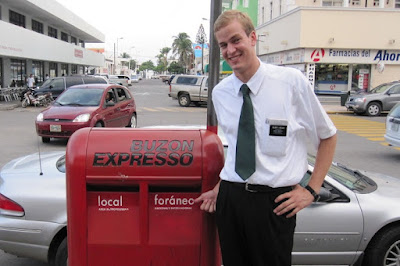November 7, 2007 – November 10, 2007
The Pico de Orizaba, a huge stratovolcano about 60km south of Xalapa. At more than 18,000
ft., it is one of the tallest mountains in North America. On a clear day, you
can even see it from the coast, about 120km away.
Whenever they
can, missionaries try to teach families. When families are taught together, the
family members can help each other adjust to the life changes that come with
adopting a new religion and remind each other about the importance of keeping commitments
that missionaries invite them to make. But teaching families also complicates
certain aspects. It can be hard to schedule times when everyone is home for the
missionaries to visit, or one family member’s doubts or disagreements can influence
the rest of the family to stop meeting with the missionaries.
My first week
in the field, we met two families that were interested in our message. The
first was the Martínez family, made up of Ana and Bonifacio and their two young
boys. Elder Guerra and his previous companion (whom I had replaced) had gotten
Ana’s contact info somehow, so we walked down to her house in the Fredepo area
of the Reserva neighborhood.
Fredepo in the evening.
Fredepo was
among the poorest parts of our area. All the roads were made of dirt, and when
it rained or got foggy (as it frequently did), the roads would turn into a deep
mud. Most of the houses were made of either exposed cinder blocks or sheets of
metal or wood. The Martínez family’s house was made of both. They had a couple
of unfinished rooms made of concrete and a larger front room made of metal and heavy
cardboard sheets. The floor was just dirt. I had to stoop pretty low to walk in
through the makeshift door, which was secured with a chain and lock when they weren’t
home. I was surprised to see a TV and a large stereo system in their front
room. I guess some things are just more important than a floor.
I was amazed at
how receptive Ana was. She listened intently to what we taught about our church’s
beliefs and how it’s blessed our lives. After only the first visit we were talking with
her about her becoming a member of the church. We hadn’t yet met her husband,
Bonifacio. She also told us he was a state police officer and regularly got
assigned out to various cities for days at a time. We also found out that they
weren’t civilly married. They’d had a Catholic wedding ceremony but had never registered
it with the state. This mattered to us because Mormons believe that, in order
to satisfy commandments regarding sexual purity, cohabitating couples need to
be legally married. The Martínezes would have to obtain a civil marriage before
they could become members of the church. Still, though, Ana said she wanted to
come to church with us that Sunday, so we looked forward to seeing her there.
I remember
being a little confused about the Martínezes’ surnames. In Hispanic culture, a
person’s name generally consists of one or two given names followed by the
paternal last name and then the maternal last name. Women do not change their
last names when they marry. For example, Bonifacio’s last names were Martínez
De la Cruz, Martínez being the last name of his father, and De la Cruz being
the last name of his mother. As it turns out, Ana’s last names were Martínez
Martínez, meaning her parents both had the same paternal last name before they
were married. Collectively, Ana and Bonifacio’s family would be also referred
to as the Martínez Martínez family. The reason this is so confusing is just
that Martínez is a very common last name, like “Smith” or “Johnson” in the U.S.



No comments:
Post a Comment